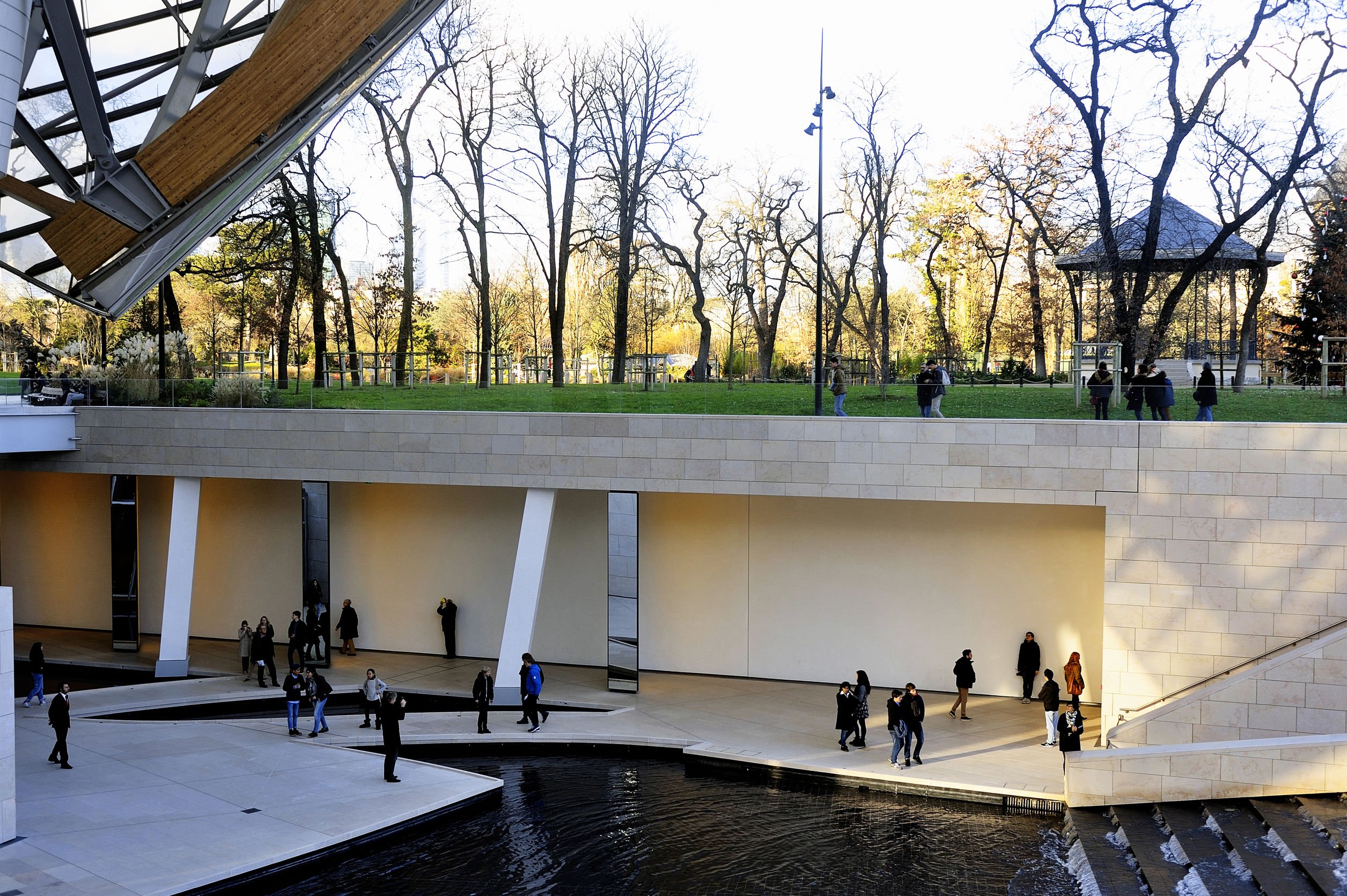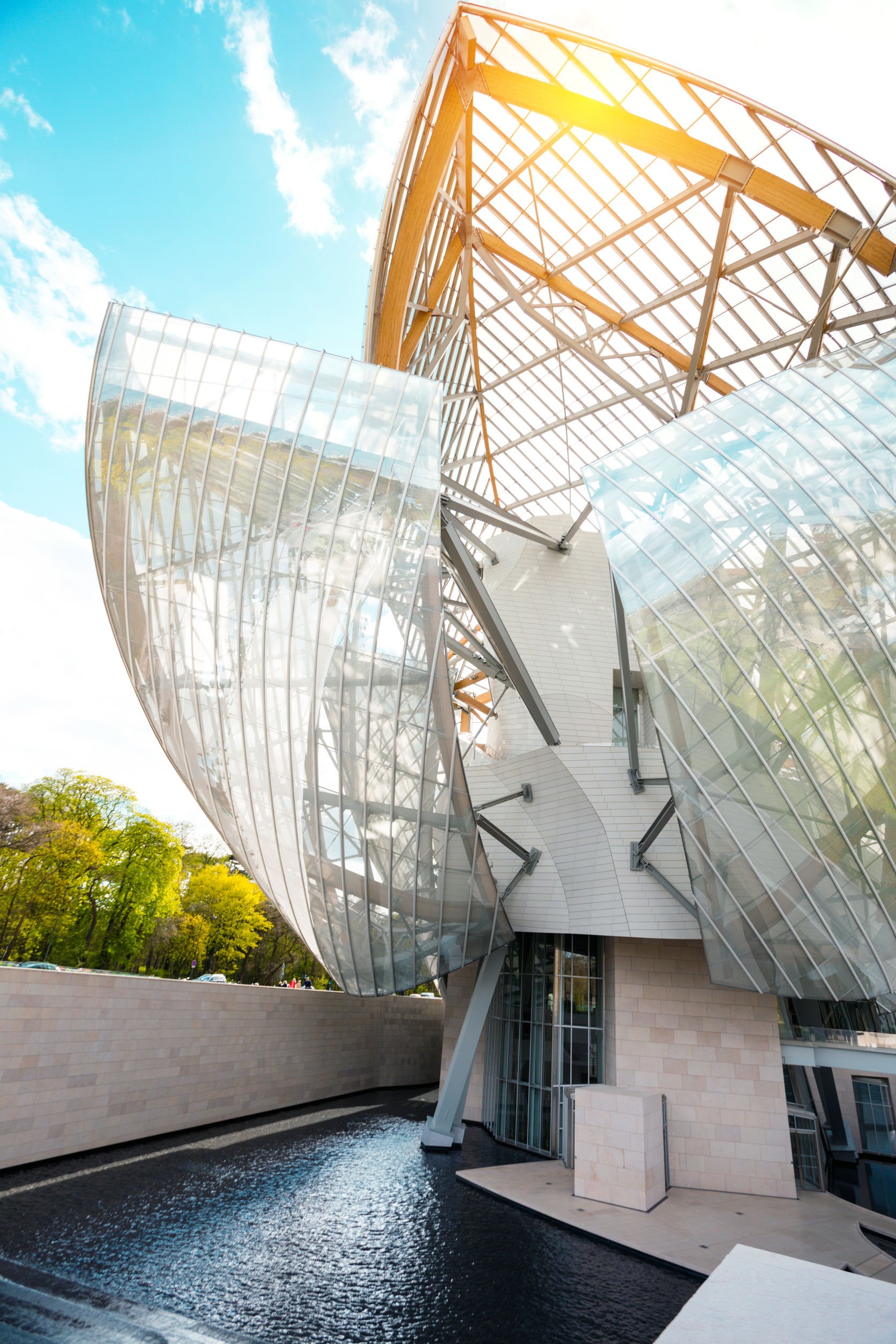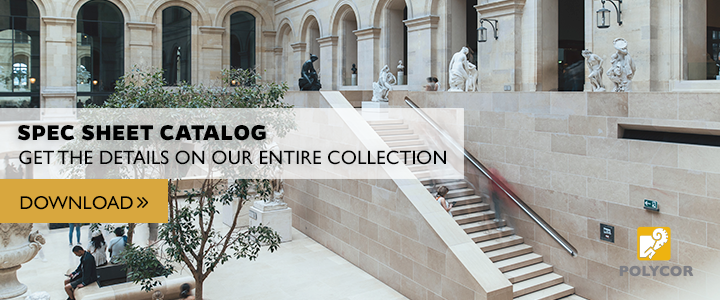%20(1).jpg?width=2448&name=Fondation%20Louis%20Vuitton%20-%20Rocherons%20Dor%C3%A9%20(24)%20(1).jpg)
The Louis Vuitton Foundation has been a center of art and culture in Paris since it opened in 2014. Funded by the luxury goods powerhouse LVMH Moët Hennessy–Louis Vuitton, the building, a museum and cultural center, was designed by noted architect and king of amorphous design Frank Gehry and incorporates locally quarried French limestone throughout the design. Gehry conceived the building’s soaring, inspiring architecture during a series of conversations with Bernard Arnault, chairman and CEO of the French luxury-goods conglomerate.
From the public-at-large to building and design industry professionals, many have marveled at the progressive and forward-thinking final result. The building is striking and original, with a low profile design that disguises its 126,000-square feet of art space. The building resembles a giant sailboat, which appears as if in motion, thanks to a series of angled and overlapping monumental glass “sails" that seemingly wave in the breeze.

Sunken plazas weave throughout the Iceberg zone
Underneath this ship-like exterior of billowing glass sits 11 art galleries, called the Iceberg. This signature arts center’s walkways, benches, cladding, treads and pavers found in the promenades feature locally-sourced ROCHERONS DORÉ CLAIR™ limestone from the Burgundy region, a touch that Arnault insisted upon. The stone originates from one of four of Polycor's best-known French limestone quarries—all located in the Burgundy region—that together add thirteen stones of varied color and character to an extensive portfolio of natural stones. The stones’ earthy beige tones, with occasional dashes of pinkish-hued calcite veining, add a subtle color and exceptional elegance to this cultural landmark. When architects use regional materials and traditions, the public’s response is usually positive: there is a sure connection between the building and its surroundings. And at a time when buildings and construction are responsible for nearly 40% of all carbon emissions worldwide, it's also reassuring when a design intent keeps sustainability at its core, which is exactly what has inspired the Foundation.
.jpg?width=473&name=Fondation%20Louis%20Vuitton%20-%20Rocherons%20Dore%CC%81%20(14).jpg)
The solution to buildings' greenhouse gas emissions dilemma is to build sustainable buildings, ones that don't emit excessive carbon to be built and operate. What materials are best suited to obtaining this goal and what type of building does this look like? "That product exists; it has always existed. It's called a stone building. In North America and Europe, you see buildings that are 300 years old and are still very functional," says Patrick Perus, president of Polycor. "Stone by its very nature does not require energy to be produced. It's a gift of God that we harvest from the earth," he continues. And it is this aspect that has helped the building earn the French equivalent of a LEED Gold certification. In France, this is called Haute Qualité Environmentale (HQE), with a Très Performant classification specifically.
 Polycor's Burgundy quarry benefits from alternative energy sources via windmills
Polycor's Burgundy quarry benefits from alternative energy sources via windmills
On a recent visit to the quarries in France, Jasmin Randlett, Polycor’s Sustainability Manager, appreciated how much the quarries represent the community and provide a deep connection to the landscape and culture. These Burgundy quarries have been providing reliable jobs to people who live in the area for generations. Without these quarries, many of the towns would look completely different as most of the building are made completely out of stone.

The Foundation's reflecting pool in the lower level outdoor plaza incorporates Rocherons Doré Clair limestone in long feature walls, paving, coping and facade.
“In France, many small towns are built from local stone quarries, at most, 200 kilometres away,” said Randlett. “Those quarries built the cities and towns in the region. It’s been that way for hundreds of years.”
Over the years Polycor has made it one of their mandates to invest in updating the equipment and infrastructure of the different open air quarry sites. Rather than using blasting techniques to free the stone from the bedrock as was done in the past, it's now using more efficient, and much less intrusive, wire sawing technology. Everything from a huge block of stone to a narrow slab is wire sawed.

View from the quarry interior
As beautiful as it is durable, engineers, builders and innovators have trusted and used one-of-a-kind Burgundy limestone since the days of the Roman Empire. While centuries old buildings, bridges and cathedrals serve as testaments to the sustainability and strength of natural stone, there are increasing indications that stone is the future as well.
Many architects are becoming aware or reacquainted with the aesthetics and sustainability of natural stone. Indeed architects are entering what has been called a 'New Stone Age'. That, in fact, is the name of an exhibit at the Building Centre in London (currently closed, but scheduled to run until September 12, 2020) which celebrates “the sustainability, practicality and inherent beauty of stone” in the age of climate crisis.
.jpg?width=1000&name=Fondation%20Louis%20Vuitton%20-%20Rocherons%20Dore%CC%81%20(12).jpg) The dense, compact grain structure of the Rocherons Doré Clair limestone gives it a marble like quality in its appearance.
The dense, compact grain structure of the Rocherons Doré Clair limestone gives it a marble like quality in its appearance.
“Stone is the great forgotten material of our time,” said British architect Amin Taha of the architecture studio Groupwork. “In 99% of cases, it’s cheaper and greener to use stone in a structural way, as opposed to concrete or steel, but we mostly just think of using it for cladding.”
In France, Polycor’s Randlett also met with architects who are embracing natural stone in their projects. He recalls, especially, an informative meeting with French studio Perraudin Architecture. The architecture studio built a house out of structural stone blocks in Lyon, France, not far from the Burgundy quarries.
“Mr. Perraudin is in love with stone,” said Randlett. “He loves to talk about how easy it is to work with stone.”
[Re]Introducing French Limestone
Perraudin also owns a vineyard and built the wine cellar out of stone, again using strictly dimensional stone blocks. Indeed, the age-old tradition of building a self supporting structure without any internal framework, but rather with stone on stone, is coming back in this New Stone Age, having proven its performance over millennia.
INTERESTED IN FRENCH LIMESTONE? ORDER SAMPLES HERE
Like the Louis Vuitton Foundation, which started as a series of conversations between Gehry and Arnault before it became a visionary work of architectural couture, architects are entering into fresh dialogues about stone. The beautiful heritage stones in Polycor’s collection are beginning to challenge the ideas about concrete and steel, and looking at structurally stable, dense, durable and beautiful natural stone in a new light.
See if limestone is right for your next project. Download the Polycor Spec Sheet Catalog.
